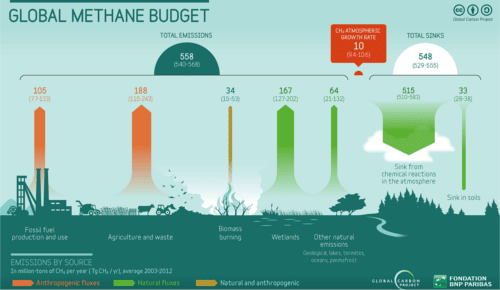
Not only CO2. Of course, carbon dioxide plays a key role in global warming , but among all the greenhouse gases, methane deserves a special attention because of its larger global warming potential. Moreover, once in the atmosphere carbon dioxide can continue to affect climate for thousands of years. Methane, by contrast, is mostly removed from the atmosphere by chemical reactions, persisting for about 12 years. Thus although methane is a potent greenhouse gas, its effect is relatively short-lived and any measures to remove methane emissions from the atmosphere can have a very rapid positive effect.
Methane is therefore becoming an increasingly important component for managing realistic pathways to mitigate climate change.
Since pre-industrial level its atmospheric concentration has more than doubled due to human activities. After a period of stabilization in the early 2000s, methane concentrations are rising again since 2007, and faster than at any time in the past two decades since 2014. This is the trend underlined in a study recently published on Earth System Science Data (among the authors, the CMCC researcher Monia Santini from IAFES Division), complemented by an editorial in Environmental Research Letters.
The study is produced by more than 80 co-authors in the framework of the Global Carbon Project, and represents an updated global methane budget for the period 2000-2012 while integrating results of top-down studies (atmospheric observations) and bottom-up models, inventories and data-driven approaches (including process-based models for estimating land surface emissions and atmospheric chemistry, inventories for anthropogenic emissions, etc).
Results highlighted that for the 2003-2012 decade, global methane emissions are estimated (by top-down inversions) at 558 million tonnes per year.
Anthropogenic emissions represent about 60% of total global emissions.
Results showed that its atmospheric concentrations are rising faster than any time in the past two decades, with a resumed increase after 2006; since 2014-2015, methane concentrations rose even faster and its current levels in the atmosphere are approaching the most greenhouse-gas-intensive scenario of the last IPCC report, that is RCP8.5.
A likely major driver of the recent rapid rise in global CH4 concentrations is an increase of biogenic emissions mostly from agriculture and waste management: enteric fermentation which is a natural part of the digestive process for many ruminant animals where anaerobic microbes, called methanogens, decompose and ferment food present in the digestive tract while producing methane as byproduct; landfills and waste handling; rice cultivation, represent about 60% of anthropogenic emissions, that is associated with human activities.
Other sources including emissions from the use of fossil fuels have also increased.
Tropical regions play the most significant role as contributors to the atmospheric growth: the largest emissions has been recorded in Tropical South America, South-East Asia and Africa (almost 50% of global emissions). The other high-emitting source regions are China, central Eurasia and Japan, USA, Russia, India and Europe. In particular, a dominance of wetland emissions has been recorded in the tropics and boreal regions, while a dominance of agriculture and waste emissions has been recorded in India and China. A balance between agriculture and waste and fossil fuels has been observed at midlatitudes, for example in Europe.
Emission estimates from inventories/models (bottom-up approach) suggest larger emissions (736 million tonnes per year) mostly because of larger natural emissions from individual sources such as inland waters, natural wetlands and geological sources; it’s likely that some of these individual emissions reported by the bottom-up approaches are overestimated and improved emissions inventories and estimates especially from inland water emissions will be needed.
To limit global warming to 2°C above pre-industrial levels in the future we should take into account not only CO2, but also CH4 emissions.
Despite still some uncertainties in methane sources and sinks, the recent increase in methane concentrations suggests a dominant anthropogenic contribution.
Although methane is a potent greenhouse gas, its effect is relatively short, remaining in the atmosphere for about 12 years, and obtaining a reduction in concentration of CH4 has a rapid positive effect.
Methane therefore might offers growing opportunities for climate change mitigation while providing rapid climate benefits and economic, health and agricultural co-benefits that are highly complementary to CO2 mitigation.
The data presented here can be downloaded from the Carbon Dioxide Information Analysis Center (http://doi.org/10.3334/CDIAC/GLOBAL_METHANE_BUDGET_2016_V1.1) and the Global Carbon Project.
The primary reference for Global Methane Budget 2016 is “The Global Methane Budget 2000-2012“
Additional Analyses for Methane Budget 2016 comes from the paper “The growing role of methane in anthropogenic climate change“.
For further information, read also:
- The Global Methane Budget website
- The paper “The Global Methane Budget 2000-2012”
Citation: Saunois M., et al. The global methane budget 2000–2012, Earth System Science Data, 8, 697-751, doi:10.5194/essd-8-697-2016, 2016 - The paper “The growing role of methane in anthropogenic climate change”
Citation: Saunois M., et al. The growing role of methane in anthropogenic climate change, Environmental Research Letters, 11, 120207, 2016 - An interactive view of the methane budget
- The Global Carbon Atlas: explore GHG emissions at the global and country levels, compare among countries, visualize, and download data and illustrations.


